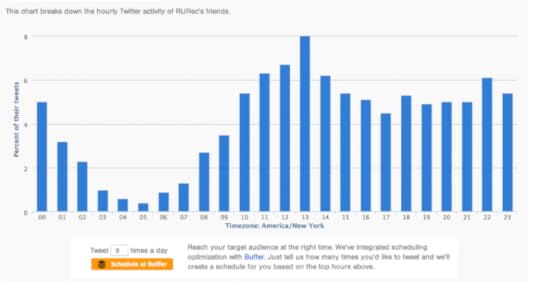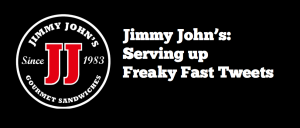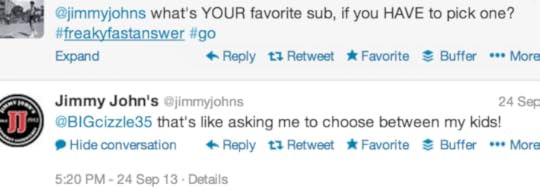Erik Qualman's Blog, page 626
October 2, 2013
Vine: 10 Creative Video Ideas for Your Business

Think Vine is just a fad for tweens and young adults? Perhaps it is…for now, but not for long. When you take a look at the following stats you can see that integrating an online video component into your overall social media strategy will be imperative for growth over the next 5 years.
Online video users are expected to double to 1.5 billion in 2016.
Only about 24 percent of national brands are using online video to market to consumers.
52 percent of consumers say that watching product videos makes them more confident in online purchase decisions.
92 percent of mobile video viewers share videos with others.
(cite: http://digiday.com/brands/celtra-15-must-know-stats-for-online-video/)
If you want to position your business or organization as a progressive leader within your industry, then creating a strong presence on Vine is a viable option for you to do just that. I have the creative juices flowing today, and in this post I’m sharing 10 ideas that anyone can use or tweak to fit their brand’s Vine campaign. Go ahead, steal these ideas!
Use Vine to make a big announcement about your business or a new big promotion. Use the weeks leading up to your announcement to build up anticipation. Using Vine, capture 3 or 4 team members each sharing a snippet of the announcement and end with a big exciting announcement! (think confetti thrown, music, cheers, etc)
While attending a promotional event or any occasion where you have several customers present, use Vine to tie together some testimonials. Vine is all about quick and to the point, so maybe each of them says the one word that comes to mind when they think of your business, product, your customer service, etc.
Create a quick how-to video. Perfect for craft, tool or tech companies that have products that often require quick how-to tutorials. Don’t just show the typical how-to, give your Vine followers a hack they can use. Try and think of something you wouldn’t find in the owners manual but is hugely helpful. Pinterest is always good for finding hacks.
Promote an awesome workplace culture. Consumers care about more than just products, they want to hear about how great it is to work for your company. Have employees use Vine to give your followers a virtual tour of the office or an inside look behind the scenes at your company.
Along the lines of ‘behind the scenes,’ get into the warehouse or factory where your product is made and show the process from soup to nuts.
Use Vine to create a killer stop motion video. Setting up for an event? Making something by hand? Get a quick video snippet of each step in the process to produce a creative stop motion video.
Infuse some play and silliness into your videos. Take video snippets while trying to stack the most amount of your product as high as it will go. Keep stacking and save just enough seconds to catch the grand finale where it all falls down. If you are promoting a new product that is meant to be durable, this is a great way to show it’s durability.
Along thew lines of durability, use Vine to show how much you can push, pull, prod at or drop your product without it breaking. Customers are MUCH more likely to buy in to an authentic-looking Vine video than some infomercial they believe is staged.
Feature unique uses for your product. Spend some time searching Pinterest and you are sure to find someone that is using your product in a new and inventive way. Once you find a few of those unique uses for the product, feature them in a series of Vine videos.
Are you in the food industry? Vine is perfect to show quick how-to videos and recipes for your product. Search #recipes and you will see how some people are already doing this. Add some production value by creating a chef character and have them dress the part…even if its just a little with a chef hat. Use an employee with a good sense of humor, and you got yourself a series of fun Vine videos for your customers.
These are just a few ideas. If you have any other ideas or have seen other brands use Vine in creative ways, please comment and share them below. Vine may not be HUGE right now when you compare it to the mammoths like Facebook, Twitter and YouTube, but there is something to be said for it’s place in the future. So if you want your customers to see you as a forward thinking company, get on Vine and try out some creative ideas. Even if your base is not one Vine, you can share the videos on Facebook Fan Pages and on Twitter.
[image error]
October 1, 2013
Video Analytics: How it Works, It’s Benefits and it’s Limitations

With the constant technological evolutions of new forms of video, the role of video analytics has never had more relevance. Broadly speaking, video analytics refers to the extraction of meaningful and relevant information from digital video. It’s primary concern is with the content of video. By building on research in computer vision, pattern analysis and machine intelligence, video analytics are able to detect people, objects and their surroundings and continuously analyse them, their movements & any suspicious behaviour. It has proved irrefutable in the worlds of surveillance, retail and transportation, providing security and safety and with the prospect of further developments on the horizon, their significance and importance can only grow.
How Video Analytics Work
For the majority of video analytic systems, they work in a series of processing steps. As a fundamental first step, the content needs to dissect what is happening in the video, frame by frame. Video analytic systems work on these two key concepts:
Motion Detection: By examining each pixel in the frame, the video analytics software is able to pick up even the slightest movement.
Pattern Recognition: Objects are distinguished within a frame. Specific objects/patterns can be programmed for recognition and will be recognised within the frame.
Once analysed, the system then qualifies these changes in each frame, correlates qualified changes over multiple frames, and finally, interprets these correlated changes. Should any change happen, i.e. object is moved, goes missing, or new object added, the software immediately recognizes it and sends out an alert.
The Benefits of Video Analytics
Video analytics offers many benefits to a new or existing CCTV system. Video surveillance is a tricky and time-consuming business, and keeping track of everything that is going on requires a lot of manpower. Video analytics allows you to minimise the hassle that goes into 24/7 surveillance. Through the use of sophisticated algorithms & pixel by pixel analysis, they can pick up on the smallest of details. Analytics filters can be intelligently tailored to meet specific security or business needs as well, making them even more efficient for your needs.
The Limitations of Video Analytics
Whilst video analytics undoubtedly holds great promise and has already demonstrated it’s worth in a number of areas. That said, the world of video is constantly evolving and this is true of video analytics too. The expectations of video analytics seem to be greater than what can realistically be delivered. Pattern recognition and object/motion detection are all achievable however the extent to which they can prevent and solve incidents is prone to exaggeration. For example, if a user wishes to identify unattended baggage in a busy railway station at peak hours, the system will end up generating too many false alerts and the readings will not be reliable.
There is also a problem with their accuracy. License plate recognition has been around a long time and is well proven, however it is still not 100% accurate. Face recognition is notoriously difficult to perform reliably, and is extremely easy to get around and for them to work with any degree of accuracy a high quality headshot
[image error]
Some Companies Use Social Media to Repair Their Image

Social media meltdowns can become high-profile PR disasters for businesses. Look no further than this summer’s Amy’s Baking Company debacle for an illustration of what not to do.
But social media can also be used as a force for good, repairing a company’s relationship with its customers and boosting its reputation.
Here’s how:
Show You Care
Seeing Twitter as a perfect customer service platform, Comcast launched the @ComcastCares Twitter account.
Using this account, the company’s community manager, Bill Gerth, provided quick and transparent replies to customer concerns and complaints.
By showing his enthusiasm for helping customers — and by not making excuses for company mistakes — Gerth improved customer service and the company’s reputation. Comcast later added several more customer service Twitter accounts, building on Gerth’s success.
Fix Problems Quickly
On Sept. 11, 2013, a guest at the San Diego Marriott Mission Valley hotel noticed a sign in the lobby, which read, “In remembrance of those we lost on 9/11, the hotel will provide complimentary coffee and mini muffins from 8:45 to 9:15 a.m.”
Upset by the callous appearance of the message, the guest tweeted about the sign. Marriott was quick to respond, apologizing for the incident and reminding its hotels about sensitivity when commemorating major events.
By responding quickly and issuing a sincere apology, Marriott won points back from customers.
Monitor Mentions
Your online reputation can take a major hit after only a few negative tweets or Facebook mentions. That’s why it’s important to keep an eye on mentions of you online.
There is a variety of tools at your disposal to keep track of social media mentions of your company. These range from free options like Google Alerts and Social Mention to paid services.
Once you spot a negative mention, make sure you respond quickly.
Apologize for the problem, explain how you’re going to fix it, and then try to take the conversation offline by sending a direct message via Twitter or a private message via Facebook.
By taking it offline, you get the negative conversation out of the public spotlight. And by working to resolve the customer’s problem, you may turn her negative opinion into more positive posts about you.
Hire a Professional
If all else fails, consider hiring a professional reputation management company to repair your online image.
A more expensive option than handling it yourself — companies can charge anywhere from a few hundred to a few thousand dollars for their services — this may be your best course of action if your negative press is dominating search results for your business.
As with hiring any vendor, however, be careful about that you trust with your online reputation. Before forking over cash to any reputation management service, be sure to check references and look for reviews. You don’t want to end up with an even bigger image problem than you started with.
Social media has a lot of potential to either help or harm your online image.
Which way it will go for you depends on how you use it and how clear you are about your social media policies with your employees.
The good news is, if disaster strikes, you can use those same social media profiles to rebuild your reputation.
Photo credit: whitewebservices.com
[image error]
How Social Media Solves Crimes

Believe it or not, police are now using social media as a way to gather evidence and solve crimes, from examining photos to getting the word out about missing children.
In fact, a survey conducted by LexisNexis Risk Solutions found that of the 1,221 officers surveyed, 80 percent have used social media to solve crimes. Most of these officials say that Facebook is the best source of information. Check out these few ways that officials have solved crimes due to social media posts.
Gathering Evidence against Murder Suspects
Image via Flickr by SimonQ錫濛譙
Numerous cases use social media to help convict murder suspects. For example, Melvin Colon, who faces murder charges along with drug and weapon related crimes, confirmed officials’ suspicions with his Facebook posts.
Not only did he have photos of himself displaying gang signs, but he updated his statuses by bragging about earlier criminal behavior and by threatening others. Ronnie Tienda Jr. is just another example. He was convicted of gang-related murder in a 2008 Texas case based on his MySpace photos and updates.
Identifying Suspects
Not only do officials use social media to gather evidence on suspect behavior, but they use it to find who their suspects are. As with the Boston bombing during the 2013 Boston Marathon, police officials used pictures and videos from witnesses’ social media profiles to help identify the bombers.
Of course, in most cases as sensitive as this one, speed was a huge factor of our law enforcement’s success. It is no doubt that when a case that needs the utmost care but also fast results comes up, officials need fiber optic speeds, or dependable, high speed DSL Internet.
Identifying Links between Gang Members
When police are tracking down a gang, social media plays a huge role in identifying who is involved in the gang activity. In Cincinnati, police arrested 71 people in 2008 by using social media to determine the members of the gang.
The officials of Cincinnati collaborated with the University of Cincinnati’s Institute of Crime Science to create detailed databanks using not just police records, but information obtained from social media. This detailed report helped the police establish links between different suspects.
Gaining Access to Suspect’s Posts
While gaining access to criminals’ posts and photos may sound easy for law officials to do, they can’t get direct social media information without a warrant. While this is a rare method of gaining access, they have had success, such as in a 2006 case where Darrin Anderson was sentenced to 12 years in prison after creating a fake Facebook profile to chat with minors and engage in sexual conduct with them.
There are ways to get around the warrant, however. For one, people who are friends with criminals on social media sites can give police access to their account so that officials can see what the criminal shares with their friends publicly, as in the case with Melvin Colon. However, police also create fake profiles and friend the suspect themselves to gain access to this information. While this is against most social media guidelines, it’s not illegal and is a method that has helped solve various crimes.
Police solve crimes with social media in many other ways, such as by using the sites as a world-wide wanted poster. Read about these stories and learn more about how officials solve crime at at CNN.
[image error]
September 30, 2013
Get Your Head Out of the Sand: Progressive Leaders Use Social Media

Lost amidst stories about Farmville and Anthony Weiner’s inappropriate tweets is the tremendous potential for digital leadership. The platform, whether LinkedIn, Twitter or Pinterest, doesn’t matter. Today’s most progressive leaders are recognizing and leveraging the benefits of social media. For those who dismiss digital initiatives as a distraction, it’s time to stop making excuses, learn enough to make informed decisions, and focus on the future.
Social media serves to humanize leaders and reveal authenticity in a way that a biography on an organizational website cannot. Leaders who share values, thoughts, and their personality with their followers can imbue trust and respect over time. The reach and efficiency of communication that social media affords was unthinkable just a few years ago. So why haven’t more leaders taken advantage? Here are a few common excuses:
I don’t have time! Every leader’s time is precious and prioritizing tasks is a constant challenge, but social media doesn’t need to be a significant time drain. Many effective leaders spend less than 15 minutes a day with social media and have gained loyalty, new relationships, and goodwill from their staff and constituents.
It’s shallow and narcissistic. We all know the perception that these platforms are mired in posts about everyday drudgery like “what I ate for lunch.” Remember, you control your connections. Don’t “follow” people who don’t enrich your thinking. Decide what you want your legacy to be–then post accordingly.
Traditional methods of email and phone calls are better suited to business. Ugh. Guardians of the status-quo have uttered similar words since before carrier pigeons and the telegraph were the rage. Technologies evolve. Social media is one of many strategies. Seek to understand the benefits of each approach and choose the right tool for the job.
The learning curve is too steep and I’m afraid I’ll make a mistake. Many things appear to be complex until you take the time to understand how they work. If you’re not sure how to get started, ask a friend or colleague to guide you. Observe and gain ideas passively from other leaders in your field before you go “live” with your posts.
Customers use social media to complain. They do. But, isn’t it better to know immediately when problems arise so you can correct misinformation and fix issues quickly? Great leaders deliberately seek timely feedback–positive and negative–to refine their efforts to create the best product or service for their constituents.
Political affiliations aside, one exemplar of smart social media leadership is the mayor of Newark, Cory Booker. On an average day, he tweets over a dozen times to celebrate, inform, and regularly respond to criticism, praise, and pleas for assistance. Just a quick review of Mayor Booker’s tweets [link] elicited the following descriptions: courageous, kind, generous, funny, responsive, informative, direct, innovative, supportive, loyal, action-oriented, culturally aware, helpful, and he stands up for his beliefs. 1.4 million followers know him for these traits. That level of intimacy and dialogue with a leader across such a vast audience would have been impossible just a few years ago. For additional examples of effective leaders, I’ve included tweets from Beth Comstock (GE’s CMO), Richard Branson (founder of the Virgin group) and Santa J. Ono (President at University of Cincinnati).
If you are still uncertain about investing time in developing a social media presence, consider a few ways that social media benefits leadership:
1. REINFORCES VALUES–Social media allows you to model behavior, actions, and values that you seek from others. If you want your constituents to be responsive, engaging, innovative, and transparent, demonstrate those traits through the information and stories you share.
2. RELATIONSHIP BUILDING–Social media can forge new relationships across regions, industries, and cultures, while enhancing existing relationships. Your social media connections can serve as resources, advocates, and test audiences for new ideas. Leaders use the power of crowd sourcing to collaborate, identify issues, and solve difficult problems.
3. CRISIS MANAGEMENT–Disasters occur in every business. When they do, social media swiftly transmits your message to a broad audience. It allows for instant distribution of multimedia content, including images, audio, and video. Getting ahead of the story with accurate and trusted information can prevent the “negative spin” rampant in our hyper-connected world.
4. LEARNING–Social media networks allow you to follow, learn from, and ask questions of others who have a wide range of expertise and perspective. Answers and guidance often come in minutes and hours versus the weeks or months needed not long ago. I’ve also found there to be a great willingness and spirit to help others succeed in the digital universe. It is a reciprocal culture. Feel free to learn but also teach others–isn’t that the definition of leadership?
One warning about leaders with “private” profiles: People may wonder, “What are you hiding?” Moreover, no one’s profile is really private. It’s not difficult for a disgruntled “friend” to cut and paste your thoughts and share with the world. Consider loosening up your privacy settings and being more intentional about what you post. Remember, the better people know and understand you, the more they’ll trust and help you – and the better leader you’ll be.
Engagement in the digital world is a marathon, not a sprint, and it’s best to build your network before you need your network. Be patient, find seasoned mentors, and start creating your digital leadership legacy today.
[image error]
September 29, 2013
Are Your Employees Causing You Social Media Heartburn?

A Chrysler employee, while making fun of Detroit drivers, used the F-word on the company’s Twitter page. The employee was promptly fired.
Domino’s employees posted a YouTube video of themselves ridiculing Domino’s and their customers, and handling food in an unethical manner. They were fired as soon as managers found out about their actions.
Employee misconduct on social networking sites can cause major headaches for owners of businesses of all sizes.
And, with the fast-changing nature of social media, a simple tweet can spread far and wide in a matter of hours, damaging your company’s daily reputation.
Here’s how to create a social media policy that protects your company while still letting employees engage with customers:
Build your policy as a team
In order to ensure that your policy addresses all of the needs of your particular business, creating it should be a team effort.
People on the team could include your company’s CEO, HR director, marketing director, IT director, and all staff directly involved in your business’s social media.
Getting input from a wide variety of specialties within your company will help you create a well-rounded policy that will help your staff respond appropriately in case of a social media crisis.
Create both overall and site-specific guidelines
Focusing on just one social media site, or being too general about your overall social networking guidelines, can lead to confusion and costly mistakes.
Instead, create a general policy that defines who will be allowed to post to your company’s social media profiles, how they are allowed to do so (including legal compliance and maintaining your company’s voice), and how they are to directly interact with customers on social platforms.
Then, create separate sets of guidelines for each specific social media site your company uses.
Make sure everyone understands legal regulations
Depending on your industry, you may need to follow specific legal regulations for how you can communicate with your customers.
These regulations may include HIPAA (for the healthcare industry), FERPA (if you’re in the education industry), and fair employment regulations.
If your business is subject to these regulations offline, they will still apply on social media. Make sure your employees fully understand the rules, and give them specific examples of what they can and cannot do.
Understand your legal responsibilities
Under the National Labor Relations Act, some employee activity on social media may be protected, and you could land yourself in hot water by restricting it.
For example, employees have the right, whether or not they’re members of a union, to discuss employment conditions with their fellow employees. This includes such conversations that take place on social media — and may even include casual Facebook conversations.
For this reason, you need to be very careful about telling employees how they are allowed to use their own personal social media accounts. In order to make sure you’re staying within the law, consult an attorney who’s familiar with the NLRA to double-check your social media policy.
Employee use of social media doesn’t have to cause you to chew antacids all day.
By creating clear guidelines for everyone involved with your corporate social networking accounts, you can give yourself — and your employees — some peace of mind.
Photo credit: www.michiganemploymentlawadvisor.com
[image error]
September 27, 2013
Jimmy John’s: Serving up Freaky Fast Tweets

Consumers are experiencing your brand, and instead of just telling a neighbor or colleague about the experience, they are talking about it on Twitter with thousands of followers. If your target demographic is 16-24 you have no choice in the matter…71% of 16-24 year olds go online when they have a problem with a product . Gone are the days of deciding whether or not to have a Twitter account, it’s time to put your Twitter account to work and engage with your customers. In this post, I am explaining how Jimmy John’s is modeling the way in the ‘Social Care’ and ‘Digital Voice’ categories, and how you can start implementing their strategies with your customers.
The screen capture below represents a model Twitter account with a strong digital voice providing unparalleled social care:
Jimmy John’s has decided to go “all-in” with social media. Specifically Twitter. One tweet at a time, they have created one of the most engaging digital voice’s I’ve come across.
If you have ever ordered a sandwich from Jimmy John’s you have grown accustom to their “Freaky Fast” service. Well, their motto to make and deliver your sandwich #FreakyFast in a record breaking time, also matches their social media strategy.
Here’s what they are doing well:
Digital Voice
1. Tracking the conversation – Creating a business around the motto #FreakyFast in their service, delivery and through speedy social media engagement, they have opened up the doors for their customers and fans to engage with them – on a minute to minute basis.
2. They are your best friend – If you want to do social media right you must connect with your audience. Social media relies on a digital voice that is engaging, provides humor, has human characteristics and is relevant.
Perfect example:
3. It’s not all about them – When you look at their Twitter feed, close to 90% of their tweets are @replies. Why? Because to do social right and connect you have to understand that it’s not all about the PUSH! Twitter is the best platform where you can listen to your customers on daily basis using free resources such as TweetDeck or paid programs like Radian6.
Now, let’s look into how they’re providing unparalleled customer service.
Social Care
1. #FreakyFast tweets – Some brands on social already have a pretty strong digital voice and built a large fan base. However, they are missing the second part: providing timely replies to solve any problem or negative comment. Social media isn’t seasonal or 9-5. They have built a team to engage 24/7 and to be there for their customers.
2. Customer service – We have all experienced bad service or poor food, turning to Twitter or Facebook to complain first – a lot of times before we even leave the restaurant. Jimmy John’s has a team tracking the conversation to monitor negative comments, complaints and they are actually doing something about it. They are sharing advice to “call the store” with the store’s phone number, offering coupons, or just a shoulder to lean on. To be honest, sometimes a complainant through Twitter is magnified and when we know someone is there to listen and apologize, the pain goes away. In return, Jimmy John’s holds onto happy fan that will most likely share their positive customer service experience.
3. Updates – On daily basis, you will see their fans profess their love for their sandwiches and will ask “when is a store opening by me?” Jimmy John’s community managers reply saying “we’re on it”, “great idea for our next store” or “our grand opening is next week.”
Everything Jimmy John’s is executing through social media is one to one marketing – providing information, engaging and at times consoling their customers. This is branding and customer service at it’s finest. In addition, they are telling the story of Jimmy John’s, spreading their motto and connecting with an audience even when they are not eating one of their subs.
What do you call it – sub, hoagie, grinder or hero?
Kevin O’Connell – @koco83
Content Marketing Specialist – Portfolio
[image error]
September 26, 2013
The Effect of Social Media on Commerce

The power of social media as a whole on consumer spending is far heavier than you probably imagine. This infographic on the rising influence of social media on commerce puts the financial picture of facebook, twitter, YouTube, blogs, and more into stunning perspective.
The facts are difficult to believe, though we probably all saw this day coming. It’s just here faster than we realized. Social media has an enormous influence on consumer purchases, and billions of dollars are spent online. Among the many jaw-dropping facts included in this infographic is the fact that visitors to retail websites are ten times as likely to make a purchase when they are referred from a social media site. That could be why half of social media marketers reported a 500% ROI.
Researchers estimate that by 2015, more than half of all web commerce will be directed by social media influence. Considering the fact that $189 billion is spent annually via the web, that’s a huge role for social media to play. Imagine nearly $100 billion in business being determined by the power of facebook and twitter.
You don’t have to imagine a world in which social media directs our spending; we’re in that world now. If you’d like to understand that world and harness its power, this infographic is definitely worth a look.
Click image to see a larger version The Rise of Social Commerce via Fedelta Point of Sale
The Rise of Social Commerce via Fedelta Point of Sale
[image error]
September 25, 2013
Tweet at the Right Time and Maximize Your ROI

We’ve all read posts or seen infographics talking about the best time to tweet, but what if I told you that this data could be customized to your followers? The time and resources you are investing in managing Twitter is valuable, and data shows that 73% consumers are following businesses on Twitter to get updates on future products, promotions, etc. Amplifying the potential reach to your customers with the information they want is critical. If you want to maximize your ROI on Twitter, it’s simple…match the times your tweeting with the times your followers are most likely to view the tweets.
This summer I utilized several social media analytic platforms to assess past content and audience engagement for the accounts I manage. I was also looking to find triggers that could increase the performance of our content in the future. One of the web-based analytic programs I came across was Followerwonk. This web app helps you explore and grow your social graph for Twitter. A lot of features are free and the tip I am about to share does not require any upgrade or payment.
A key feature of this app is the ability to do a deep-dive into your Twitter analytics: follower counts, ages of account users and social authority. However in this post, I want to highlight the app’s ability to report the hourly Twitter activity of your followers. In doing this, you can identify the best times to tweet. This metric is one of the most important ones you will need to be intentional and efficient when managing your social media platforms.
Here’s how to do it:
1. Go to Followerwonk and simply connect your Twitter account.
2. Once connected, click the middle tab “analyze followers.”
3. Type in your twitter handle and set to “analyze their followers.”
4. Press “do it” and then you will be amazed at the analytics that come your way.
The first chart helps you determine the best times to schedule your tweets because it illustrates the most active hours for Twitter users. See an example of this below. Also, if you are using Buffer as a content scheduler, with a click of a button it automatically syncs your Buffer scheduler to utilize the best times to tweet. Ultimately, just this one graph will give you the greatest chance to reach your target audience and the other features will help you analyze the rest of your Twitter account.
Sample Chart:

Kevin O’Connell – @koco83
Content Marketing Specialist – Portfolio
[image error]
Turning your Video Viral in 3 Easy Steps

What makes one video go viral above another? How can you make sure you video stands a chance of being seen on the world wide web? With over 100 hours of video uploaded onto YouTube per minute and the success of your content becoming increasingly decided by the audience, the idea of turning your video viral can seem a daunting task and potentially fruitless. But never fear! Whilst there is no 100% guarantee that your video will be a hit, there are several tips and tricks you can employ to increase your chances & have your video seen by the ‘right’ people.
Step 1: Create Something Worth Sharing
Starting with the basics, the content of your video has to be good enough to encourage viewers to share it among themselves. To do this, your target audience should be at the heart of your campaign and your content should revolve around their needs and interests rather than those of your product or services.
Past successful campaigns have shared several commonalities. They have delivered an element of humour, surprise or shock – often with little relevance to their product or brand. Things like T-Mobile’s Flash Mobs and the Old Spice Guy commercials have all tapped into one of those three emotions and have all gone on to generate millions of views and shares.
Equally valuable is the perception of your video. The information we share on social media increasingly defines who we are to those viewing it – or at least how we want to be seen. In order to influence video sharing, it’s important to ask yourself: ‘When a user shares this video, what are they saying about themselves?’
A mistake many marketers make is by trying to overcomplicate their content by cramming in too much information or overselling. In some cases, video might not be the best format for getting people to buy your products, but rather helping familiarise an audience with your brand.
Step 2: Maximise the Video’s SEO
It may seem obvious, but before it can be shared, your video needs to be found. Whatever video sharing site you choose – YouTube, Vimeo, Metacafe – making the video easy to find is crucial in maximising video views. As YouTube is by far the most popular video sharing platform as well as the second largest search engine, it’s potential reach is massive. There are three particularly important areas you need to consider when filling out the video’s meta-date, these are; the title, description and tags of your video. Filling this information out tactically can drastically boost the search rankings of your content.
Step 3: Distribute Wisely
Just as your video won’t go viral without great content, it won’t happen without a bit of a push either. It is really worth investing time and money in a solid distribution strategy, and you should really try and allocate an equal amount of money for distribution as you do the content.
Make sure to maximise your existing channels. This includes your website, blog, YouTube channel, Facebook, Twitter etc. You may already have enough followers to start the viral ball rolling, and marketing on these platforms can really give a significant boost to your videos views and shares.
Don’t be afraid to approach significant sites and players in your respective field. Popular bloggers et al will offer access to a wider, relevant audience of people who otherwise may not have come across your brand. Placing content in front of well-known, influential people is a potentially powerful form of seeding. It may cost you, but can ultimately help in your push to go viral.
Above all, when trying to create viral content – above all – you need to keep your fingers crossed. Even with the greatest content and the strongest strategies, the most successful video campaigns tend to have luck on their side too. Just one person coming across your video can make all the difference – so don’t lose hope and good luck!
Madeleine Hammond is a Marketing Executive at Skeleton Productions, a UK based video production company.
[image error]










